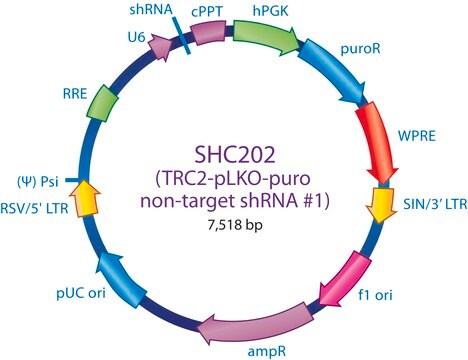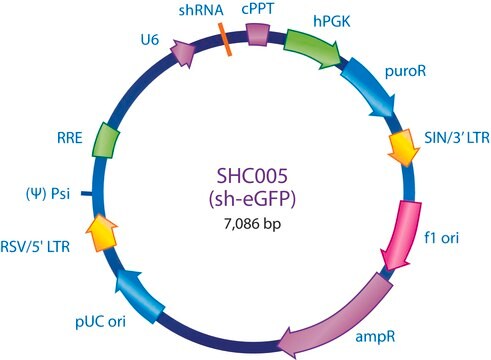推荐产品
產品線
MISSION®
濃度
≥1x106 VP/ml (via p24 assay)
技術
capture ELISA: 106 TU/mL using p24
運輸包裝
dry ice
儲存溫度
−70°C
正在寻找类似产品? 访问 产品对比指南
一般說明
当使用MISSION® TRC shRNA克隆进行实验时,选择适当对照品是您的实验设计的关键要素,以便准确解释敲低结果。 MISSION对照转导颗粒是监测转导效率的关键阳性对照。
想要查看更多应用数据、实验方案和载体图谱,请访问 sigma.com/shrna。
想要查看更多应用数据、实验方案和载体图谱,请访问 sigma.com/shrna。
This shRNA non-mammalian control was designed using our Turbo GFP sequence and may cause some knockdown of tGFP. For maximum knockdown of tGFP, please refer to SHC004, SHC004V, SHC004H, SHC204, or SHC204V.
Small interfering RNAs (siRNAs) expressed from short hairpin RNAs (shRNAs) are a powerful way to mediate gene specific RNA interference (RNAi) in mammalian cells. The MISSION product line is based on a viral vector-based RNAi library against annotated mouse and human genes. shRNAs that generate siRNAs intracellularly are expressed from amphotropic lentivirus viral particles, allowing screening in a wide range of mammalian cell lines. In these cell lines, MISSION shRNA clones permit rapid, cost efficient loss-of-function and genetic interaction screens.
The lentiviral transduction particles are produced from an shRNA lentiviral non-target control plasmid. It is useful as a negative control in experiments with the MISSION shRNA target sets.
Unlike murine-based MMLV or MSCV retroviral systems, lentiviral-based particles permit efficient infection and integration of the specific shRNA construct into differentiated and non-dividing cells, such as neurons and dendritic cells,1 overcoming low transfection and integration difficulties when using these cell lines. Self-inactivating replication incompetent viral particles are produced in packaging cells (HEK293T) by co-transfection with compatible packaging plasmids.2-3
In addition, the lentiviral transduction particles are pseudotyped with an envelope G glycoprotein from vesicular stomatitis virus (VSV-G), allowing transduction of a wide variety of mammalian cells.4 The lentiviral transduction particles are titered via a p24 antigen ELISA assay and pg/ml of p24 are then converted to transducing units per ml using a conversion factor. The conversion can be viewed at: www.tronolab.com.
Small interfering RNAs (siRNAs) expressed from short hairpin RNAs (shRNAs) are a powerful way to mediate gene specific RNA interference (RNAi) in mammalian cells. The MISSION product line is based on a viral vector-based RNAi library against annotated mouse and human genes. shRNAs that generate siRNAs intracellularly are expressed from amphotropic lentivirus viral particles, allowing screening in a wide range of mammalian cell lines. In these cell lines, MISSION shRNA clones permit rapid, cost efficient loss-of-function and genetic interaction screens.
The lentiviral transduction particles are produced from an shRNA lentiviral non-target control plasmid. It is useful as a negative control in experiments with the MISSION shRNA target sets.
Unlike murine-based MMLV or MSCV retroviral systems, lentiviral-based particles permit efficient infection and integration of the specific shRNA construct into differentiated and non-dividing cells, such as neurons and dendritic cells,1 overcoming low transfection and integration difficulties when using these cell lines. Self-inactivating replication incompetent viral particles are produced in packaging cells (HEK293T) by co-transfection with compatible packaging plasmids.2-3
In addition, the lentiviral transduction particles are pseudotyped with an envelope G glycoprotein from vesicular stomatitis virus (VSV-G), allowing transduction of a wide variety of mammalian cells.4 The lentiviral transduction particles are titered via a p24 antigen ELISA assay and pg/ml of p24 are then converted to transducing units per ml using a conversion factor. The conversion can be viewed at: www.tronolab.com.
應用
MISSION® pLKO.1-puro Non-Mammalian shRNA Control Transduction Particles has been used as a negative control in ACSS2 (cytosolic acetyl-CoA synthetase) knock down study. It has also been used to study the effects of transduction.
To see more application data, protocols, vector maps visit sigma.com/shrna.
法律資訊
MISSION is a registered trademark of Merck KGaA, Darmstadt, Germany
推薦
产品编号
说明
价格
儲存類別代碼
12 - Non Combustible Liquids
水污染物質分類(WGK)
WGK 3
閃點(°F)
Not applicable
閃點(°C)
Not applicable
個人防護裝備
Eyeshields, Gloves, multi-purpose combination respirator cartridge (US)
历史批次信息供参考:
其他客户在看
The Nrf1 CNC-bZIP protein promotes cell survival and nucleotide excision repair through maintaining glutathione homeostasis
Han W, et al.
The Journal of biological chemistry, jbc-M112 (2012)
Takeshi Fujii et al.
Journal of orthopaedic research : official publication of the Orthopaedic Research Society, 36(5), 1334-1345 (2017-10-29)
Although the number of patients with intervertebral disc (IVD) degeneration is increasing in aging societies, its etiology and pathogenesis remain elusive and there is currently no effective treatment to prevent this undesirable condition. The unfolded protein response (UPR) is a
P2X4 assembles with P2X7 and pannexin-1 in gingival epithelial cells and modulates ATP-induced reactive oxygen species production and inflammasome activation
Hung SC,et al.
PLoS ONE, 8(7), e70210-e70210 (2013)
Panu K Luukkonen et al.
Journal of hepatology, 67(1), 128-136 (2017-02-27)
Carriers of the transmembrane 6 superfamily member 2 E167K gene variant (TM6SF2 Liver biopsies were taken from subjects characterized with respect to the TM6SF2 genotype, serum and liver lipidome, gene expression and histology. In vitro, after TM6SF2 knockdown in HuH-7
David Gilot et al.
Nature cell biology, 19(11), 1348-1357 (2017-10-11)
Competition among RNAs to bind miRNA is proposed to influence biological systems. However, the role of this competition in disease onset is unclear. Here, we report that TYRP1 mRNA, in addition to encoding tyrosinase-related protein 1 (TYRP1), indirectly promotes cell
商品
An experiment to directly compare three methods of lentiviral transduction of Jurkat cells was conducted in order to determine the method that yields the greatest transduction efficiency.
实验方案
This detailed procedure allows you to transduce Mouse Embryonic Fibroblasts (MEF) using MISSION ExpressMag Super Magnetic Kit.
Global Trade Item Number
| 货号 | GTIN |
|---|---|
| SHC002V | 4061837018237 |
| SHC002VN | 4065269394310 |
我们的科学家团队拥有各种研究领域经验,包括生命科学、材料科学、化学合成、色谱、分析及许多其他领域.
联系客户支持











